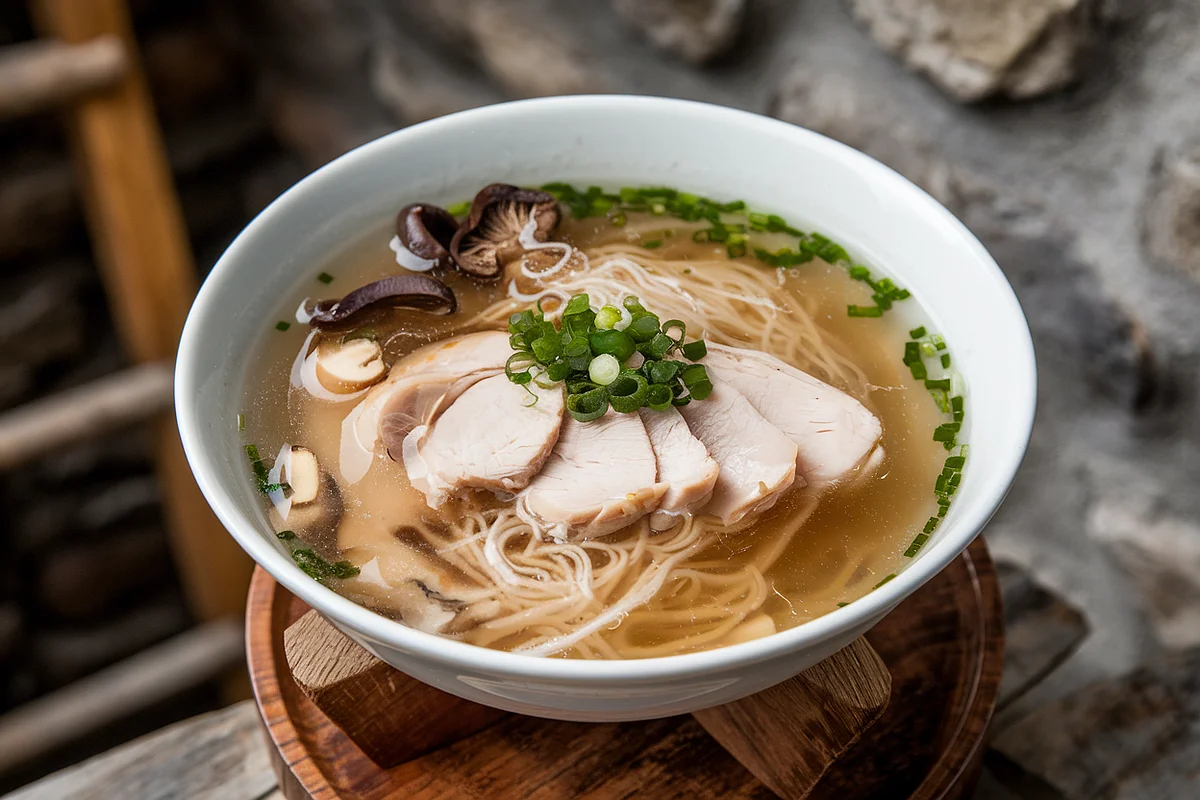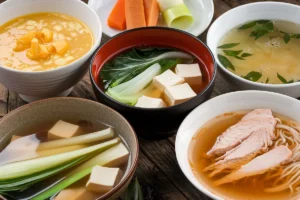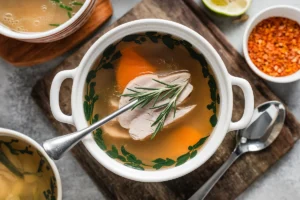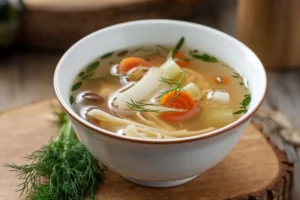Clear broths are a delightful part of global cuisine. Unlike thick or creamy options, these soups focus on broth clarity, the absence of thickening agents, and overall lightness. People on liquid diets or those seeking a simple, healthy meal often gravitate toward these types of soups. In this article, we’ll explore what transparent soups are, the different varieties worldwide, how to prepare them, their health benefits, and ways to make them at home.
Introduction to Clear Soups
Broth-based soups, as their name suggests, consist of a transparent liquid. Cooks prepare these light dishes by simmering vegetables, meat, or bones in water for an extended period. This process allows flavors to infuse the liquid without thickening agents such as flour or cream, resulting in a light, easily digestible dish, quite different from heavier options like chowders or bisques.
The goal in preparing such soups is to create a flavorful broth that remains free from cloudiness or impurities. From simple vegetable broths to rich meat consommés and flavorful Asian soups, you’ll find a wide variety to suit your palate. Whether you’re looking for a low-calorie meal or something comforting and hydrating, this category of soup offers versatility.
Additionally, many doctors recommend clear broths for individuals on liquid diets or recovering from surgery or illness. Their gentle effect on the stomach and their ability to hydrate and provide essential nutrients make them ideal for recovery meals.
History and Origins of Transparent Soups
The history of these soups stretches across multiple cultures. Centuries ago, people began making them because they were easy to prepare and required minimal ingredients. Households would use leftover bones and vegetables to create nourishing meals. For instance, in Europe, broths made from simmering bones and vegetables became dietary staples, often forming the base for other dishes.
In addition, Asian cuisines place light soups at the heart of traditional meals. Countries like Japan, Thailand, and Vietnam feature broths in their daily meals. For example, dishes such as miso, pho, and tom yum exemplify light, flavorful options that complement other courses.
Moreover, for centuries, these soups have played a significant role in medicinal diets. Doctors recommended them to patients recovering from illness or surgery, as they provide hydration and essential nutrients without overwhelming the digestive system. Therefore, their simplicity and ease of preparation make them ideal for fasting regimens or liquid-based diets.
Key Features of Clear Soups
Broth-based soups stand out for a few defining characteristics:
- Transparency: These soups prioritize clarity, ensuring the broth remains free of cloudiness. By gently simmering the ingredients, cooks extract flavors without affecting the broth’s clarity.
- Minimal Ingredients: Cooks focus on extracting the natural flavors of vegetables, meat, or bones without adding thickeners or heavy seasonings. This allows the purity of the ingredients to take center stage.
- Easy Digestion: The simplicity and lightness of these soups make them easy to digest. Thus, they are ideal for individuals with digestive issues or those recovering from illness.
- Simple Preparation: You can prepare these soups with minimal fuss. By simmering ingredients in water or broth and then straining the solids, you achieve a flavorful liquid.
Popular Varieties of Broth-Based Soups
There are many types of broth-focused soups worldwide, each with unique flavors and regional variations. Below, we explore some of the most popular options globally:
1. Broth-Based Soups
These soups are perhaps the most common. First, cooks make them by simmering meat, bones, or vegetables in water to extract their flavors. The resulting broth can be served as is, or it can act as a base for more complex dishes.
Chicken Broth
This classic option involves simmering chicken bones and vegetables such as carrots, onions, and celery. Consequently, the result is a light, nourishing broth that works well as a standalone dish or as a base for other soups and stews.
Beef Broth
To create beef broth, simmer beef bones for several hours. This process extracts gelatin and nutrients from the bones. The result is a rich, flavorful liquid. While beef broth is often used in hearty dishes, it can also be enjoyed on its own.
Bone Broth
Bone broth has become especially popular in recent years, particularly among those following paleo or keto diets. Made by simmering animal bones (often with some meat attached) for long periods, this collagen-rich broth is thought to support gut health and joint recovery. Bone broth can serve as a base for soups or be consumed as a health-boosting beverage. Learn more about the health benefits of bone broth.
2. Vegetable-Based Soups
For vegetarians or those seeking a lighter alternative, vegetable-based broths are ideal. These soups extract flavors from simmered vegetables and are often seasoned with herbs for added flavor.
Basic Vegetable Stock
A simple vegetable stock involves simmering a combination of vegetables such as carrots, onions, celery, and leeks. This broth can be enjoyed alone or used as a base for other dishes. For more information, check out this guide to making vegetable stock.
Vegetable Clear Soup
A lighter variation of vegetable stock, this soup typically includes a mix of vegetables like carrots, beans, mushrooms, and cabbage. Furthermore, this dish works well as a detox meal and can be customized with various vegetables based on preference.
3. Asian Clear Soups
Asian cuisine is renowned for creating light soups packed with flavor. Despite their clear appearance, these soups deliver intense depth, often using ingredients like ginger, garlic, and soy sauce to add complexity.
Miso Soup (Japan)
Miso soup is a traditional Japanese dish made with fermented soybean paste (miso) and dashi (a Japanese soup stock). Common ingredients include tofu and seaweed. In this case, the miso paste dissolves into the clear broth, resulting in a soup that’s both nutritious and delicious.
Tom Yum Soup (Thailand)
This hot and sour Thai soup features a clear broth made from shrimp stock, lemongrass, kaffir lime leaves, and chili. Although light, Tom Yum offers bold flavors, often including shrimp, mushrooms, and fresh herbs.
Pho (Vietnam)
Pho is a Vietnamese noodle soup made with a fragrant beef or chicken broth, rice noodles, and fresh herbs. Slowly cooked with spices like star anise and cinnamon, the broth develops a distinct aromatic flavor.
Vegetarian vs. Non-Vegetarian Clear Soups
Both vegetarian and non-vegetarian soups appeal to different audiences, but the main difference lies in the base ingredients:
- Vegetarian Soups: These soups derive flavor from a mix of vegetables like carrots, celery, onions, and mushrooms. Thus, the result is a light yet flavorful broth, free of meat.
- Non-Vegetarian Soups: Non-vegetarian varieties typically use a meat or bone base, such as chicken or beef broth. On the other hand, meat and bones add richness and depth to the broth, along with essential nutrients like collagen and gelatin.
Health Benefits of Light Soups
Broth-based soups provide numerous health benefits, making them a staple in diets focused on wellness. Here are some key health benefits:
1. Low in Calories
Broth-based soups consist primarily of water, making them low in calories. Therefore, they are perfect for individuals aiming to lose weight without sacrificing flavor.
2. Hydration
These soups are an excellent way to stay hydrated. Because they consist mostly of water, they help replenish fluids, especially important when you’re sick or during hot weather.
3. Detoxifying
Clear vegetable soups play a prominent role in detox diets. Their simple ingredients help cleanse the digestive system, flushing out toxins while providing essential nutrients and minerals.
4. Gut Health
Clear soups, especially bone broth, contain collagen, which helps repair the gut lining. Consequently, these dishes are an excellent choice for people with digestive issues.
5. Post-Surgery Recovery
Doctors often recommend these soups for individuals recovering from surgery or illness. They provide essential nutrients without overworking the digestive system. Thus, their ease of digestion and hydration capabilities make them ideal recovery foods.
How to Make Clear Soups
Preparing a broth-focused soup requires minimal ingredients. The objective is to create a flavorful broth without cloudiness or solid particles. Here’s how to make it:
- Choose Your Ingredients: Start by selecting high-quality vegetables, meat, or bones. These will form the foundation of your soup.
- Simmer Slowly: Keep the heat low while simmering the ingredients. This step ensures the flavors are extracted without clouding the broth.
- Skim the Foam: As the broth simmers, impurities may rise to the surface. Skim them off periodically to maintain clarity.
- Strain the Broth: After simmering, strain the broth through a fine-mesh sieve or cheesecloth. This removes solid particles, leaving you with a clean, flavorful liquid.
FAQs About Broth-Based Soups
What is the difference between broth and stock?
Broth is typically made from meat (sometimes including bones), while stock is primarily made from bones, which gives it a richer flavor and gelatinous texture when cooled.
Can clear soups help with weight loss?
Yes, these soups are low in calories and can help fill you up without adding excess calories to your diet, making them ideal for weight management.
How long does it take to make broth?
Depending on the ingredients, broth typically takes between 30 minutes to a few hours to prepare. Bone broths, for example, take longer as they need to simmer to extract nutrients from the bones.
What vegetables are best for these soups?
Common vegetables include carrots, onions, celery, leeks, and mushrooms. In particular, these vegetables add flavor to the broth without affecting its clarity.
Can these soups be frozen?
Yes, they freeze well. Make sure to cool the soup completely before freezing it in an airtight container. Some vegetables, like mushrooms, may not freeze as well, so consider adding them fresh when reheating.
Customizing Your Clear Soup
You can easily customize these soups to suit your taste or dietary needs:
- Add Fresh Herbs and Spices: Fresh herbs like parsley, cilantro, or thyme can elevate the flavor. Spices such as pepper or turmeric also work well to give it a kick.
- Add Protein: For a more filling meal, consider adding shredded chicken, tofu, or eggs.
- Vegetarian Variations: Incorporate a wider variety of vegetables like zucchini, broccoli, or spinach to increase the nutritional content.
Conclusion
Light soups are a simple yet nutritious addition to any meal. Whether you’re seeking a light starter, a detox meal, or a comforting dish during illness, broth-based soups offer a nourishing solution. From classic chicken broth to miso and pho, these soups cater to a wide variety of tastes and preferences.



